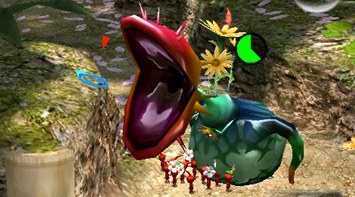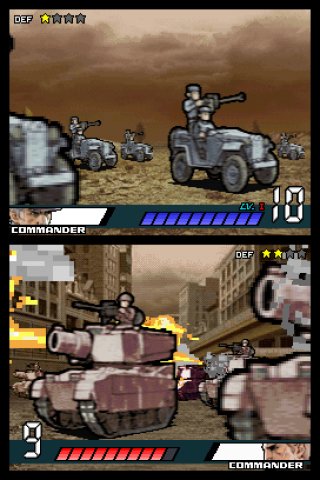A strategy is a specific plan of game action(s) most likely to gain some kind of advantage. By this definition you can make all kinds of strategies in a game irrespective of its depth or complexity. Strategizing is how we plan ahead and make smarter moves. So it should be obvious that game information is needed to formulate strategies. The more information we have, the better strategies we can make. Yet some game developers resist just "giving" the player information. For example, if there's a bit of math involved in calculating damage, some games leave these calculations (and equations) up to the player to figure out. Obviously, there's a balance to strike in this area. But if you're going to err, err on the side of revealing too much. Remember, it's a secret to everybody.
Puzzle games get a lot of leeway as far as obscuring and not revealing information goes. Often times, the challenge of a puzzle game involves sorting through complexities, weighing permutations, and experimenting with possibilities in order to find the answer. And for some puzzle games, after you find the answer, there's no replay value in solving the puzzle again. Like a story spoiler, you can't unlearn what you know.
I was quite surprised and relieved at the amount of transparency in Desktop Dungeons (DD). In a roguelike, every move can be crucial to your survival. In DD, every enemy's level, attacks, type, HP, and estimated damage are given once you spot the enemy. Displayed at all times is your own character's stats including HP, MP, attack strength. If all of this information isn't enough for you, the game also calculates the success of your next attack including options like death (game over), safe (no counter damage), a successful hit, or victory (vanquishing the enemy).
This open information did 2 things for my experience with the game. It helped me learn how damage is calculated, and it sped up my strategizing process because I never had to bust out a calculator or resort to too much trial and error. This allowed me to focus on engaging with the more dynamic parts of the game (namely the decay of resources). Even with this high level of transparency, there's still some mystery. Certain resistances to attacks aren't factored in to the given information, and some gods award you with piety points in mysterious ways. It's the best of both worlds.
For action games with real time skills to stress (dexterity, timing, reflex) in addition to knowledge skills, forcing the player to run calculations before they can make informed decisions can slow down the engagement before it even starts. One way to compensate for a lack of adequate information is to develop one's LTM (simply memorizing everything). The more elegant solution involves designing elements that convey lots of key information quickly and effectively. Besides these highly communicative visual elements, I want to highlight the functional importance of lifebars.
Used widely across many different video game genre, a value bar is simply a visual, non-numeric way of presenting some value displaying the current value relative to the maximum value. In most cases, developers display lifebars because the survival of your character(s) versus the opponent's character(s) depends on how the HPs compare. The average gamer simply cannot run multiple, multi-digit math calculations on the fly while playing an action game.
Appealing to our visual acuity (reflexes) lifebars communicate exactly what we need at a glance. We simply want to know how much relative damage is done (or HP gained) so we can calculate how many more hits of the same type we can take. This basic information is the foundation of how we evaluate the risk-reward balance of our actions. It's the foundation of how we become better players.
This wouldn't be a critical-gaming article if I didn't have a bunch of examples. Here they are:

Street Fighter 4: These lifebars start off solid yellow. After taking damage, the bar turns into a gradient of orange to red. If you look carefully, exactly half way down the bar there's a small hitch or kink in the lifebar. This half way point is especially important to be aware of because that's when you're Ultra attack is activated guaranteed. Though the characters have different maximum health values, players can easily gauge how much damage they're doing based on how the lifebar moves. Experienced players have a feel for the "relative math," which comes in handy for picking certain combos or strategies. When either player is close to a KO, you can see how both players switch up their game. On a final note, there's a mode that hides the lifebars from the player. It's amazing how blind you feel without it.

Pikmin: The Pikmin lifebars are circles, a design that allows them to fit compactly over enemies and other objects. At half life, the circle turns yellow, and at about 1/8 life it turns red. There are some enemies in Pikmin 2 are susceptible to different types of attacks based on how much damage they've taken. The color changing lifebars really helps bring this design element into focus.

Pokemon vs Final Fantasy. Pokemon is a rare example in that it's an RPG that doesn't display the amount of damage you do from attacks. All you have to gauge your power is the lifebar. And it works. The slow speed that the bars drain adds to the suspense and excitement of battle. The Final Fantasy series has finally added lifebar displays over the enemies in FF12 and FF13. Without this information, players can only stab in the dark by attacking as much as possible in hopes that they'll do enough damage. Eventually, players can develop LTM to get a feel for how effect their offense is. Normally, being in the dark in this way holds back the development of strategy. But depending on how limited the RPG battle system is, there wouldn't be a large gain for including lifebars.

Advance Wars vs Fire Emblem. In Advance Wars unit health is mostly displayed as a number next to each on the map. By mostly, I mean that the number (representing attack and defense strength) is a rounded figure. Experienced players know that there are invisible decimal digits behind all values. At times when these decimals are important factors in developing a winning strategy, the lifebars that are displayed during the battle animations give a more accurate representation of the data. Like Desktop Dungeons, players can analyze the attack damage they'll potentially give to targets. This feature goes a long way in making the hidden, ultra complex spreadsheet of data more transparent focusing gameplay on strategic moves rather than tricky calculations. Fire Emblem is the opposite. Though its Mega Man style battle lifebars are more accurate with each "pixel" representing 1 HP, this information isn't easily displayed on the map view.
Mario vs Henry Hatsworth: In Super Mario Bros. lifebars simply aren't needed. Many enemies die in one hit and others like the Koopa Troopa, have distinct animations to indicate their current state. The most you have to memorize is that the Bowser bosses take 5 fireballs to defeat. The enemies in Henry Hatsworth have HP that's much harder to gauge. Fortunately, you get the feel for enemy health because neither the enemies nor Henry level up throughout the game to throw off the invisible calculations. The bosses in HH have lifebars though.

Zelda Series: Instead of a fixed lifebar container, the heart based lifebar in this series can be expanded over the course of the game. The number of hearts one has is a way of measuring how far one has gone in their adventure. In many ways this system is more intuitive and than multiple lifebars.
Bangai-O Spirits: All the lifebars are displayed on the touch screen. At a glance you can determine the health and position of all the remaining enemy targets.
Ikaruga: This game has a dynamic/generic lifebar at the top of the screen that displays the health of the last large enemy you shoot. (Small enemies generally only take 1 shot). The bosses also use this health bar, layering it multiple times with color bars (green, yellow, orange, red/death). Doing this allows the bar to move a significant amount with each shot making it easier to discern how much damage you're doing at a glance.
StarCraft II: Whether you play with lifebars on, toggled, or selected, the complete story of a battle is told only when the health of the units is clearly displayed. Commentators like HDStarcraft or HuskyStarcraft know exactly how important lifebars are to their subscribers/fans.